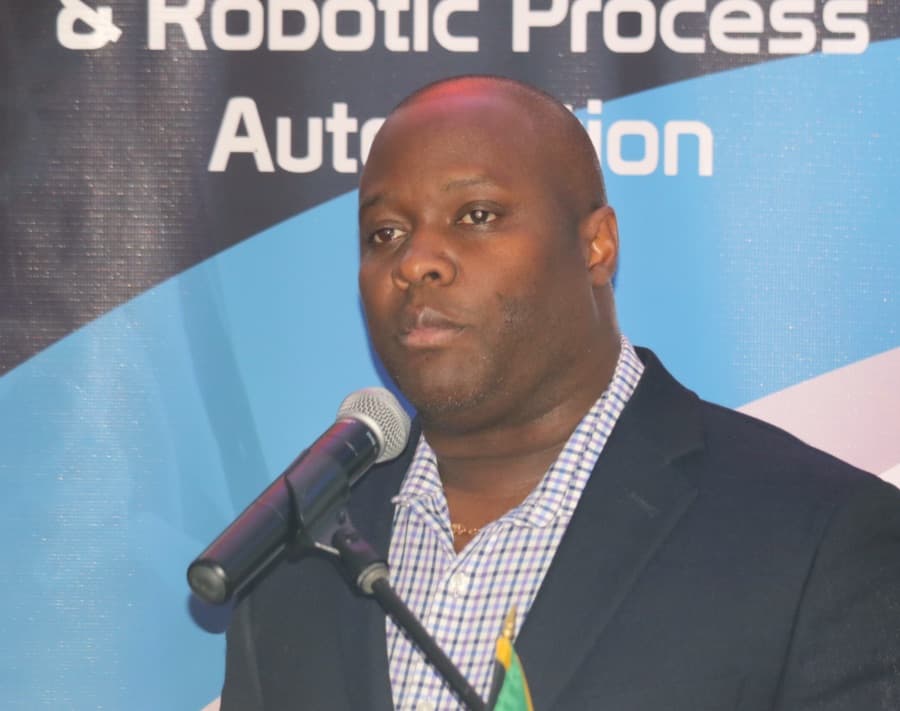
Above: Maurice Barnes speaking at the event hosted by Incus Services recently. Photo courtesy Leslie Lee Fook.
BitDepth#1178 for January 03, 2019
“It’s really not about technology, that’s the easy part,” said Maurice Barnes, CEO of EGov Jamaica (egovja.com), that country’s implementation arm for digitally enabled governance.
At a recent event by Incus Services, Barnes explained how Jamaica had moved from a Fiscal Services department in April 1985 to the establishment of a forward-looking, aggressive implementation agency for creating e-government to serve a digital society.
In short, it’s the story of how Jamaica followed the Fast Forward template introduced by the T&T Government in 2005, who then proceeded to bury it in politics, gamesmanship and quick, short-term news bites that amounted to little in the long term.
In January 2013, the Jamaican government formally refocused the state agency on the implementation of ICT and EGov Jamaica began its evolution from analog government with closed operations and an internal focus to one enabled by ICT and is now moving to digital government, hallmarked by “open and user-driven approaches, process and operational transformation.”
Indeed, the Jamaican state agency’s Mission Statement is almost religious, as it seeks “to revolutionise the Government of Jamaica’s interactions with its entities, citizens and businesses to harness the power of ICT.”
“You must have some infrastructure in place to deliver these e-services,” said Barnes.
“It starts with a vision and clear objectives that will guide implementation and that vision must come from the top.”
After 20 years of talking about linking Jamaica’s government infrastructure on a wide-area network (WAN), the project began in 2017 with a German consultancy overseeing a project that will cost US$48 million over the five years it will take to network the Caribbean nation’s government services down to the community level.
Jamaica followed the Fast Forward template introduced by the T&T Government in 2005, who then proceeded to bury it in politics, gamesmanship and quick, short-term news bites that amounted to little in the long term.
The WAN is currently being built out in the Kingston Metropolitan area as fibre optic connections with a backup microwave link.
They are probably right to be concerned, since the planned network will include the establishment of government data centres and cloud services with primary and secondary sites.
Access to any government website is already zero-rated on all carriers, incurring no data charges when citizens connect to the gov.jm domain.
In other news that Jamaican carriers won’t enjoy, the government has implemented 300 community wireless access points and six free WiFi hotspots.
GovTalk and GovMail will provide secured internal communications services within the government.
A new national ID system based on electronic identification is being implemented with an IDB loan of US$68 million to create a card with embedded biometrics that provides authentication across all platforms.
“I’m pushing them to have notifications when your digital ID is accessed,” Barnes said, “like the second it is.”
“I’m pushing them to have notifications when your digital ID is accessed, like the second it is.”
Maurice Barnes, EGov, Jamaica
The JDXP is a secure data exchange platform that will share relevant, identity scrubbed government data with the private sector and Jamaica Eye is a closed circuit surveillance system that’s begun with 300 cameras with 500 more to be added in 2019.
Private businesses can connect to the network to expand its coverage.
Denmark and Australia top the list, while the United States isn’t even in the top 10. These net drops aren’t always the result of faltering projects in participating countries but can occur when other nations press ahead with their projects at a faster rate.
Barnes also noted that developing nations have favoured wireless broadband solutions over cabled infrastructure, leading former top-rated nation Estonia to drop precipitously in these first world evaluations.
The net lesson from Jamaica is to define goals, then stick to your knitting, implementing vigorously and consistently.
Trinidad and Tobago has tended to respond to its poor ranking in such indices with kneejerk efforts to raise the perception of activity instead of the measured, focused work that Jamaica has been putting in to develop a robust ICT governance infrastructure.
You get there, apparently, by going there, rather than trying to go everywhere.



